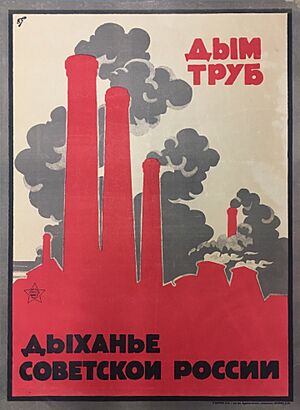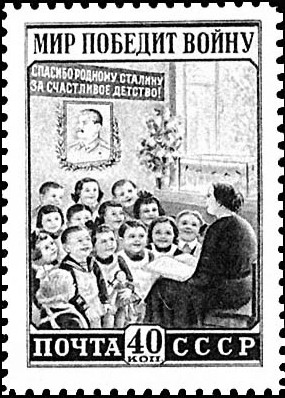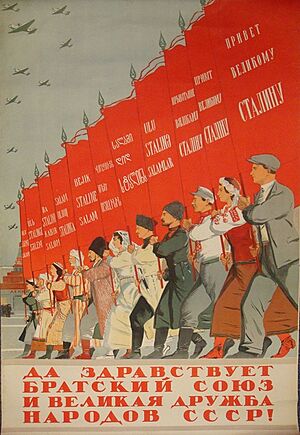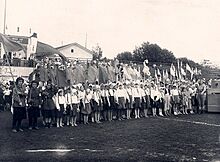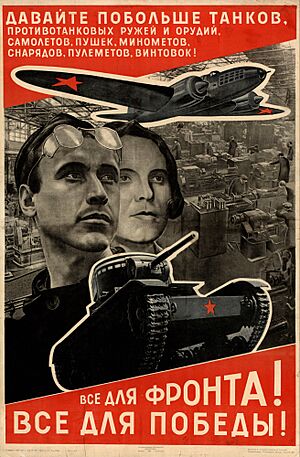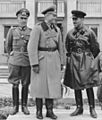History of the Soviet Union (1927–1953) facts for kids
| 1927–1953 | |
| Preceded by | History of Soviet Russia and the Soviet Union (1917–1927) |
|---|---|
| Including | World War II Cold War |
| Followed by | History of the Soviet Union (1953–1964) |
| Leader(s) | Joseph Stalin |
The history of the Soviet Union between 1927 and 1953 was a very important time. It covers the period when Joseph Stalin was in charge, from 1927 until his death in 1953. During this time, Stalin worked to change Soviet society a lot. He used a system called central planning to control the economy.
A big part of this change was the forced collectivization of agriculture. This meant farmers had to give up their private land and join large collective farms. There was also a rapid growth of heavy industry. Stalin became very powerful and created a cult of personality around himself. This meant people were encouraged to admire and worship him.
The Soviet secret police and the Communist Party helped Stalin control society. His methods included purges (removing people he didn't trust), and political repression. These actions led to millions of deaths, especially in Gulag labor camps and during famines.
World War II, known in the Soviet Union as "the Great Patriotic War," caused huge damage. About one in three deaths in World War II were Soviet citizens. After the war, the Soviet Union's armies took control of Eastern Europe. They set up or supported Communist governments there. By 1949, the Cold War began between the Western Bloc (like the USA and its allies) and the Eastern (Soviet) Bloc. This led to a long period of tension. Stalin continued his strong rule until he died in 1953.
Contents
Building the Soviet State
Growing Soviet Industry
The Soviet government used state planning to build up its industries. From 1928 to 1932, the production of pig iron (used for building) nearly doubled. Coal production also increased a lot, from 35.4 million to 64 million tons. Many new factories and industrial areas were built. These included large car plants and heavy machinery factories.
Life for workers was often very hard during this time. Stalin made strict laws about work. For example, in 1932, workers could be fired for being absent for just one day without a good reason. If you were fired, you could lose your food ration cards and your home. This made it very difficult to survive. Later, in 1940, new laws made it a crime to quit your job or even be 20 minutes late. People could be sent to prison for these things.
The Soviet government said that its first Five-Year Industrial Production Plan was almost completed in only four years. They said the plan for heavy industry was even more successful. Stalin announced this success in December 1932. During the Second Five-Year Plan (1933–1937), industry grew even faster. By 1937, coal output was 127 million tons, and pig iron was 14.5 million tons. The weapons industry also grew very quickly.
The first Five-Year Plan was very tough on workers. Miners sometimes worked 16 to 18 hours a day. If workers didn't meet their goals, they could be accused of treason. Working conditions were often dangerous. A famine happened because resources were focused on industry, and farming became less productive. People in Gulag camps were forced to work on these big industrial projects. However, conditions improved a bit during the second plan. Throughout the 1930s, industrial growth was combined with more technical and engineering education.
From 1921 to 1954, the police state was very active. It looked for anyone accused of trying to harm the system. Many people were punished for supposed anti-government crimes. This included people being sent to labor camps or even executed. The worst period of this was called the Great Purge in 1937–1938. This time removed many skilled people and slowed down industrial production.
Soviet Economy
Farming Changes

Before Stalin, farmers were allowed to own their land. But after Stalin came to power, he wanted to quickly put all farming under state control. This process was called collectivization. When peasants joined kolkhozes (collective farms), they had to give up their private land and property. The collective farms then sold their crops to the state for a very low price.
Collectivization was forced and happened very quickly. Many peasants did not want to join the collective farms. They often killed their animals rather than give them to the state. People who were seen as rich peasants, called "Kulaks," were forced to move to faraway places like Kazakhstan or Siberia. Anyone who opposed collectivization was often called a "kulak." This policy led to some executions and many deportations to special settlements or forced labor camps.
Collectivization caused a huge drop in farm production. It didn't return to earlier levels until 1940. The changes were especially hard in Ukraine. Many peasants killed their livestock. For example, in 1930 alone, 25% of the nation's cattle, sheep, and goats were killed. It took until the 1980s for livestock numbers to return to 1928 levels. Government officials, who didn't know much about farming, were sent to the countryside to "teach" peasants new ways. Even after the state forced collectivization, peasants tried to resist by farming less land and working less. The Ukrainian famine caused millions of deaths. Some historians believe this was a deliberate act against the Ukrainian people. Others say it was a terrible result of a poorly planned policy against all peasants.
By 1937, almost all cultivated land was part of collective farms. Many millions of people died from persecution or starvation during these years. Ukrainians and Kazakhs suffered the most. In Ukraine alone, about 3.5 million people died in the famines.
After World War II, the Soviet Union took over Estonia, Latvia, and Lithuania. The collectivization of farms there began in 1948. Through terror and deportations, most peasants were forced into collective farms by 1952. Farm production fell sharply in these areas too.
Fast Industrial Growth
During the time of fast industrial growth and collectivization before World War II, many more people got jobs in the Soviet Union. The number of jobs grew from 3.9 million in 1923 to 8.3 million in 1940. The number of people living in cities also increased a lot, by 30 million between 1926 and 1930.
Before this time, unemployment was a problem. But with Stalin's huge industrialization program, almost everyone had a job. The state needed a lot of workers to build up its industries. Wages were kept low, which meant the state could afford to hire many more workers than a normal economy might. Many large projects were started to get raw materials for both military goods and everyday items.
Car and truck production reached 200,000 in 1931. While few Soviet citizens could afford a car, these factories helped build up the country's industrial strength. A minimum wage was set in 1937. Workers were also allowed to have small private gardens to grow some of their own food. However, most Soviet workers lived in crowded shared housing and faced extreme poverty.
Soviet Society
Propaganda and Control
Soviet leaders knew that propaganda was very important. They took control of all newspapers, magazines, and radio stations. They used these to spread their messages. Stalin himself was an editor for Pravda, a major newspaper. All official media had the same opinion. Typewriters and printing presses were closely watched to stop people from publishing things the government didn't approve of. Any illegal writings were severely punished.
Education for All
To help industrial workers be more skilled, the Soviet Union started a big program to improve education. They built many new schools and increased the number of students. In 1927, about 7.9 million students were in schools. By 1933, this number grew to 9.7 million students in over 166,000 schools. Many new specialist departments and institutions were also built. This led to a big increase in people who could read and write, especially in the Central Asian republics.
Women's Role
Women in the Soviet Union gained more rights, at least on paper. They were supposed to get the same education and have the same rights in the workplace as men. While these goals weren't always fully met, efforts to achieve them generally improved women's lives. Many women were hired in department stores. A propaganda campaign in the 1930s said that the "New Soviet Woman" was also a working woman.
Health Improvements
Stalin's policies also helped improve healthcare. Soviet people had access to free health care and education. Large-scale vaccination programs helped stop diseases like typhus and cholera. These diseases became very rare, and the number of babies who died decreased a lot. As a result, people's life expectancy (how long they were expected to live) increased by over 20 years by the 1950s.
Youth and Komsomol
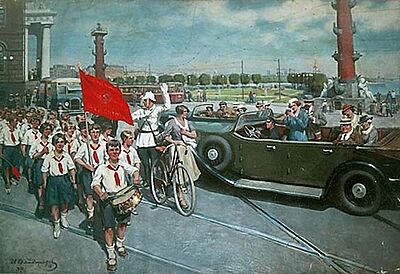
The Komsomol, or Youth Communist League, was a new organization for young people. It was designed to teach them Communist values. Komsomol members were often sent to help with important projects, like building factories or working in coal mines. They were meant to be energetic activists who would influence other workers.
In 1935, Komsomol changed its rules to allow more people to join based on their skills, not just their background. This led to more educated young people joining. Under Stalin, the death penalty was even extended to teenagers as young as 12 years old in 1935.
Modern Life
Urban women in the Soviet Union were among the first to give birth in hospitals and receive prenatal care. Education also improved, making the generation born under Stalin almost completely able to read and write. Some engineers were sent abroad to learn about new industrial technology. Many foreign engineers also came to Russia to help.
Transportation improved with new railways, though many were built using forced labor, which cost thousands of lives. Workers who produced more than their goals, called Stakhanovites, received rewards. Their achievements were often used in propaganda to encourage others.
Religion Under Attack
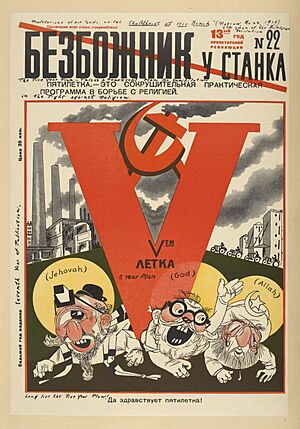
The Soviet government began attacking the Russian Orthodox Church in 1917. In the 1930s, Stalin increased this attack on all organized religions. Most churches and monasteries were closed. Thousands of religious leaders were imprisoned or executed. Between 1918 and 1939, many thousands of Orthodox clergy died.
The government promoted atheism (not believing in God) and said religion was old-fashioned. In 1937, Pope Pius XI spoke out against these attacks. By 1940, only a few churches remained open. At first, the attacks were mostly on the Russian Orthodox Church. But in the 1930s, all faiths, including other Christian groups, Islam, Judaism, and Buddhism, were targeted. During World War II, the government eased up on religion. The Orthodox Church was allowed to help the Soviet Army. After the fall of communism in the 1990s, religions in former Soviet republics grew again.
Ethnic Policies
The Soviet Union tried to promote the national identity of different peoples within its borders. In Central Asia, they tried to change women's roles, like starting a campaign against the paranja (veil) in 1927. However, this caused a lot of resistance.
In 1937, during the Great Purge, some ethnic groups were targeted. People from "Western" minorities were seen as possibly connected to countries that were enemies of the USSR.
The Great Purge

During this time, Stalin gained almost complete power by removing anyone who might oppose him. Between 1936 and 1938, about three-quarters of a million Soviets were executed. More than a million others were sent to harsh labor camps. The Great Purge affected many factory managers, engineers, and most of the senior army officers. The reason given was the assassination of Sergei Kirov in 1934, which some people believe Stalin himself planned. Almost all the old Bolsheviks (people who were part of the revolution before 1918) were removed.
Stalin used the purges to get rid of his rivals. People who were arrested were often forced to confess to being spies or saboteurs. They were quickly found guilty and executed. Several show trials were held in Moscow. These trials were meant to be examples for courts across the country. The secret police, first called the OGPU and then the NKVD, carried out these arrests and trials. Nikolai Yezhov, known as the "Bloody Dwarf," was in charge of the NKVD during the worst part of the purges, which was called the "Yezhovschina."
The "Great Purge" swept across the Soviet Union in 1937. Many officers in the armed forces were removed. The entire Politburo (the main political committee) and most of the Central Committee were purged. Foreign communists living in the Soviet Union, intellectuals, and factory managers were also targeted. About two million people were imprisoned or executed during the Yezhovschina. By 1938, the purges were causing problems for the country, so Stalin started to slow them down. Yezhov was eventually removed from power and executed. His replacement was Lavrentiy Beria. Arrests and executions continued until 1952, but not on the same huge scale.
During this period, people were often arrested, imprisoned, or executed without a proper trial. The secret police suspected anyone of opposing Stalin's rule. By the NKVD's own count, over 680,000 people were shot in 1937–1938 alone. Hundreds of thousands of political prisoners were sent to Gulag work camps. Most of the world did not know about the mass terror. Some Western thinkers believed the Soviets had created a successful alternative to capitalism. In 1936, the country adopted its first formal constitution, which on paper promised freedoms like speech and religion. Historians estimate that the total deaths from the Great Purge (1936–1938), including those from prison conditions, were around 700,000 to 1.2 million.
Foreign Relations (1927–1939)
The Soviet government had taken over foreign-owned companies and refused to pay debts from the time of the Russian Empire. Because the USSR openly wanted to overthrow capitalist governments, it was not initially accepted by other countries. However, after 1921, the Soviet Union began to seek trade, loans, and recognition. Other countries slowly started to trade with and recognize the Soviet government. The United States was one of the last major countries to recognize the USSR in 1933. In 1934, France suggested an alliance, and the USSR joined the League of Nations. This showed that the USSR was becoming more accepted. However, it was later kicked out in 1939 for attacking Finland.
In 1928, Stalin believed that capitalism was about to collapse. He ordered European communist parties not to work with moderate socialists. But by 1934, the idea of forming a "Popular Front" emerged. This meant communists would work with other parties to fight fascism (a type of extreme nationalism). For Stalin, this was just a useful tactic.
Relations between France and the Soviet Union were difficult at first. But when Adolf Hitler and Nazi Germany became a threat, especially with Hitler wanting to take over lands in Central and Eastern Europe, the Soviet Union changed its policy. In May 1935, the USSR made agreements with France and Czechoslovakia to help each other if attacked. Stalin ordered the Communist International (Comintern) to form popular fronts against fascism. However, this agreement was weakened by distrust of the Soviet Union and Poland's refusal to let the Red Army cross its land.
The Soviet Union sent military aid, including weapons and soldiers, to the Republican side in the Spanish Civil War. This support made the Republicans seem more Communist to Britain and France, which made those countries less likely to help.
Nazi Germany, Imperialist Japan, and Fascist Italy formed the Anti-Comintern Pact. This was supposedly to stop Communist activity, but it was really an alliance against the USSR.
World War II
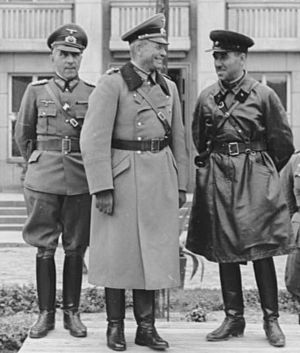
Stalin signed the Molotov–Ribbentrop Pact, a non-aggression agreement with Nazi Germany, on August 23, 1939. This pact also included a secret part that divided Eastern Europe between the USSR and Nazi Germany. The Soviet Union gained parts of Poland, the three Baltic States (Latvia, Estonia, Lithuania), and parts of Romania.
Beginning of the War
Germany invaded Poland on September 1, 1939. The USSR followed on September 17. The Soviets crushed resistance by executing and arresting thousands. They also moved many ethnic groups they didn't trust to Siberia.
After dividing Poland with Germany, Stalin demanded land from Finland. He said it was for the security of Leningrad. When Finland refused, the Soviets invaded on November 30, 1939, starting the Winter War. The goal was to take over Finland. Even though the Red Army had many more soldiers, the war was difficult for them. They were not ready for the winter weather and lacked good commanders because of the purges. The Finns fought bravely and received some support from other countries. The war ended in March 1940, with Finland giving up some land. Other countries saw the Red Army's poor performance and thought it was weak.
In 1940, the USSR occupied and illegally took over Lithuania, Latvia, and Estonia. In June 1941, the USSR started mass deportations from these countries. The Soviet government also demanded and took over parts of Romania in June 1940.
The Great Patriotic War
On June 22, 1941, Adolf Hitler suddenly broke the non-aggression pact and invaded the Soviet Union. Stalin was not prepared. Soviet intelligence was tricked by German information, and the invasion surprised the Soviet military. The first weeks of the war were a disaster. Hundreds of thousands of Soviet soldiers were killed, wounded, or captured. Entire army groups fell apart against the German attack. Soviet prisoners of war were treated very badly in German camps.
German troops reached the edge of Moscow in December 1941 but failed to capture it. This was due to strong Soviet defense and counterattacks. At the Battle of Stalingrad in 1942–1943, the Red Army severely defeated the German army. Because Japan did not open a second front in Asia, the Soviets could bring many army divisions from eastern Russia to the European front. These units were key in turning the tide of the war. The Soviet forces then launched huge counterattacks. By 1944, the Germans were pushed out of the Soviet Union. On May 2, 1945, the last German troops surrendered to Soviet troops in Berlin.
Wartime Changes
After 1944, large parts of eastern Germany came under Soviet control. On May 2, 1945, the capital city of Berlin was captured. Over fifteen million Germans were moved from eastern Germany.
During the war, a feeling of patriotism grew in the Soviet Union. The persecution of the Orthodox Church stopped. The Church was allowed to operate more freely, as long as it stayed out of politics. In 1944, a new Soviet national anthem was written, replacing the old one. These changes were made because the government thought people would fight better for their country than for a political idea.
The Soviets suffered the most in World War II. The Western Allies (like the USA and Britain) did not open a second major ground front in Europe until June 1944. About 26.6 million Soviets, including 18 million civilians, died in the war. Nazis rounded up and killed civilians in many cities. The retreating Soviet army was ordered to use a "scorched earth" policy. This meant destroying civilian buildings and food supplies so the German troops couldn't use them.
After the war, the Soviet Union controlled and influenced Eastern Europe. This was in line with Soviet ideas. Stalin wanted to punish people he thought had helped Germany during the war. He also wanted to deal with nationalism (people wanting their own independent country). Millions of Poles, Latvians, Ukrainians, and other ethnic minorities were sent to Gulags in Siberia. In 1940, thousands of Polish army officers were executed in the Katyn massacre. Also, in 1941, 1943, and 1944, entire ethnic groups were deported to Siberia and Central Asia. These included the Volga Germans, Chechens, and Crimean Tatars.
In May 1945, Stalin praised the role of the Russian people in defeating the Nazis. He said they were the leading force of the Soviet Union.
World War II caused huge destruction across Europe and Asia. The Soviet Union was especially damaged. It also had a major famine in 1946–1948, which killed an estimated 1 to 1.5 million people. However, the Soviet Union quickly rebuilt its industries. By the end of the war, it had the most powerful land army and military production in history.
War and Industry
The Soviet Union received aid and weapons from the United States through the Lend-Lease program. However, the Soviet Union's own production of war materials was even greater than Nazi Germany's. This was thanks to the fast growth of Soviet industry in the years before the war. The Second Five-Year Plan increased steel production to 18 million tons and coal to 128 million tons. The Third Five-Year Plan produced even more steel and coal before it was stopped by the war.
The Soviet Union's industrial output provided the weapons and supplies for its army. This helped it resist the Nazi attack. Some historians believe that if industry had grown slower, the German attack might have succeeded. However, life for industrial workers was very difficult. Workers were encouraged to produce more than their goals through propaganda.
Some historians also say that the Soviet Union's lack of preparedness for the war showed a flaw in Stalin's economic planning. They argue that the country was still suffering from the Great Purge and was not ready for the German invasion.
The Cold War Begins
Soviet Control in Eastern Europe

After World War II, the Soviet Union expanded its power over Eastern Europe. Some lands that Russia had lost earlier were taken back by the Soviet Union. For example, the Baltic states and parts of Poland became part of the USSR. The Russian SFSR also gained a part of Germany (now Kaliningrad Oblast).
By the late 1940s, pro-Soviet Communist Parties won elections in five countries in Central and Eastern Europe. These countries became "People's Democracies." Many people believe these elections were unfair. For the rest of the Cold War, these countries became Soviet satellite states. They were technically independent but were one-party communist states. Their leaders had to be approved by the Soviet government, and their policies usually followed the Soviet Union's wishes.
Relations with the U.S.
During World War II, the USSR needed weapons, food, and fuel from the U.S. and Britain through the Lend-Lease program. Stalin often asked the United States and Britain to open a second ground front in Europe. But the major Allied invasion didn't happen until June 1944, more than two years later. During this time, the Soviets suffered many casualties and faced the main force of the German army.
Korean War Involvement
In 1950, the Soviet Union protested that the Chinese seat at the United Nations Security Council was held by the Nationalist government of China (Taiwan). They boycotted the meetings. While the Soviet Union was absent, the UN passed a resolution condemning North Korea's actions and offered military support to South Korea. After this, the Soviet Union always attended Security Council meetings.
Life in the Soviet Union
Controlling Information
Art and science were closely controlled under Stalin. The Union of Soviet Writers had to publish writings that supported the working class. A biologist named Trofim Lysenko influenced Soviet biology studies. He rejected modern ideas about genetics. In physics, the theory of relativity was called "bourgeois idealism." Much of this control was done by Andrei Zhdanov, who was known as Stalin's "ideological hatchet man."
Stalin's cult of personality was strongest after the war. His picture was in every school, factory, and government office. But he rarely appeared in public. The country quickly rebuilt after the war. However, the focus was on heavy industry and energy, so living standards remained low, especially outside big cities.
After the War
The small amount of political freedom during the war quickly ended in 1945. The Orthodox Church was mostly left alone after the war. It was even allowed to print some religious books. But other minority religions were persecuted again.
Stalin and the Communist Party were given all the credit for winning the war. Generals like Zhukov were moved to less important positions. As the Cold War began, anti-Western propaganda increased. The capitalist world was shown as a bad place with crime, unemployment, and poverty.
In the late Stalinist period, there was an unspoken agreement between the state and the Soviet middle class. The state would allow some "normal" habits like buying consumer goods and having a family life. In return, these people would be loyal to the state. This "big deal" happened because many Soviet middle-class people expected a better life after the war. The state needed skilled experts to function. This led to more materialism and corruption. For example, romance novels, which were not allowed before the war, started to be published.
Despite the suffering, many people looked back at World War II with some nostalgia. Life after the war seemed dull and stagnant. There was a feeling that the war was won, but the peace was lost. People had hoped for a better world after the war, but it didn't happen. New subcultures emerged, like listening to smuggled Western pop music. These were sometimes tolerated or sometimes stopped by the authorities.
People also started looking for more personal space and privacy. They wanted private apartments. People in cities wanted to spend more time in the countryside, where the state had less control. For the elite, a country house (dacha) became a symbol of status. Others found personal space by studying science or moving to remote areas like Siberia. Informal networks of friends and relatives, called svoi, helped people get by. They could help with things like getting into a good university or finding goods that were hard to get. Underground poetry and samizdat (illegal literature) that criticized the Soviet system also became popular.
In the late 1940s, many young people listened to Russian language broadcasts from the Voice of America and the British Broadcasting Corporation (BBC). This led to a big campaign in 1948 to say these radio stations were "capitalist propaganda." Journals from America and Britain were also very popular with young people. They sold out quickly in Moscow and Leningrad. Historians say that young people's interest in Western culture wasn't always a rejection of the Soviet system. It was often just curiosity about the world. Many young people felt proud of their country but also wondered if there was something better outside the Soviet Union.
Another sign of people wanting more personal space after 1945 was the popularity of non-political films like musicals and comedies. The Soviet film industry had problems after the war. So, Soviet cinemas showed American and German films that the Red Army had captured. These "trophy films" were very popular. For example, the German-Hungarian musical film The Girl of My Dreams was extremely popular in 1947.
Terror by the secret police continued after the war.
In October 1952, the first party congress after the war was held in Moscow. Stalin, who was almost 73, suggested he might retire. But no one dared to agree, and they begged him to stay.
After Stalin's Death
On March 1, 1953, Stalin was found unconscious. He had suffered a brain hemorrhage and died on March 5, 1953. Some people suspect he might have been murdered, but there is no clear proof.
Stalin did not name anyone to take his place. The Central Committee met on the day he died. Georgy Malenkov, Lavrentiy Beria, and Nikita Khrushchev became the main leaders. They brought back a system of collective leadership. This meant several leaders would share power to prevent one person from becoming too powerful again.
Changes were made right away. Economic reforms focused on building more houses and lowered taxes on farmers to help them produce more. The new leaders tried to improve relations with other countries, including the United States. They worked to end the Korean War, which happened in July 1953. Doctors who had been imprisoned were released, and anti-Jewish purges stopped. Many prisoners were released in 1953, cutting the prison population in half. The secret police and Gulag systems were reformed, and torture was banned in April 1953.
Images for kids
-
Propaganda shows the use of tractors (in this case McCormick-Deering 15–30) as a backbone of collectivization. Soviet Ukraine, 1931
-
"Foreigners in Leningrad" by Ivan Vladimirov (1937), depicting Young Pioneers
-
Cover of Bezbozhnik in 1929, magazine of the Society of the Godless. The first five-year plan of the Soviet Union is shown crushing the gods of the Abrahamic religions.
-
Red Army Soldiers watching a parade on May 1, 1936, at the Beginning of the Great Purge
-
Common parade of Wehrmacht and Red Army in Brest at the end of the Invasion of Poland. At the center Major General Heinz Guderian and Brigadier Semyon Krivoshein
-
Soviet expansion, change of Central-eastern European borders and creation of the Eastern Bloc after World War II
-
Stalin with Mao Zedong, Walter Ulbricht, and Bulganin during his 70th Birthday Celebration
See also
 In Spanish: Historia de la Unión Soviética (1927-1953) para niños
In Spanish: Historia de la Unión Soviética (1927-1953) para niños


